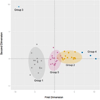Multivariate Statistical Analysis of Cigarette Design Feature Influence on ISO TNCO Yields
- PMID: 27222918
- PMCID: PMC4916500
- DOI: 10.1021/acs.chemrestox.6b00096
Multivariate Statistical Analysis of Cigarette Design Feature Influence on ISO TNCO Yields
Abstract
The aim of this study is to explore how differences in cigarette physical design parameters influence tar, nicotine, and carbon monoxide (TNCO) yields in mainstream smoke (MSS) using the International Organization of Standardization (ISO) smoking regimen. Standardized smoking methods were used to evaluate 50 U.S. domestic brand cigarettes and a reference cigarette representing a range of TNCO yields in MSS collected from linear smoking machines using a nonintense smoking regimen. Multivariate statistical methods were used to form clusters of cigarettes based on their ISO TNCO yields and then to explore the relationship between the ISO generated TNCO yields and the nine cigarette physical design parameters between and within each cluster simultaneously. The ISO generated TNCO yields in MSS are 1.1-17.0 mg tar/cigarette, 0.1-2.2 mg nicotine/cigarette, and 1.6-17.3 mg CO/cigarette. Cluster analysis divided the 51 cigarettes into five discrete clusters based on their ISO TNCO yields. No one physical parameter dominated across all clusters. Predicting ISO machine generated TNCO yields based on these nine physical design parameters is complex due to the correlation among and between the nine physical design parameters and TNCO yields. From these analyses, it is estimated that approximately 20% of the variability in the ISO generated TNCO yields comes from other parameters (e.g., filter material, filter type, inclusion of expanded or reconstituted tobacco, and tobacco blend composition, along with differences in tobacco leaf origin and stalk positions and added ingredients). A future article will examine the influence of these physical design parameters on TNCO yields under a Canadian Intense (CI) smoking regimen. Together, these papers will provide a more robust picture of the design features that contribute to TNCO exposure across the range of real world smoking patterns.
Figures





References
-
- Federal Trade Commission. 147. Vol. 32. Washington, D.C.: Office of the Federal Register of the National Archives and Records Administration and the U.S. Government Printing Office; 1967. Cigarettes: Testing for Tar and Nicotine Content, Federal Register; p. 11178.
-
- Federal Trade Commission. 134. Vol. 45. Washington, D.C.: Office of the Federal Register of the National Archives and Records Administration and the U.S. Government Printing Office; 1980. Cigaretttes and Related Matters: Carbon Monoxide, Tar and Nicotine Content of Cigarettte Smoke; Description of New Machine and Methods to be Used in Testing, Federal Register; pp. 46483–46487.
-
- Commonwealth of Massachusetts. 105 CMR 660.000: Cigarette and Smokeless Tobacco Products: Reports of Added Constituents and Nicotine Ratings. [accessed May 2016];1997 http://www.mass.gov/eohhs/docs/dph/regs/105cmr660.pdf.
-
- Commission of the European Communities. Cigarette Yield Measurement and Some Basic Steps for Laboratory Approval – Practical Guide Brussels. [accessed May 2016];2007 http://ec.europa.eu/health/ph_determinants/life_style/Tobacco/Documents/....
-
- U.S. Department of Health and Human Services. Washington, D.C.: Centers for Disease Control and Prevention, National Center for Chronic Disease Prevention and Health Promotion, Office on Smoking and Health (US); 2010. [accessed May 2016]. How Tobacco Smoke Causes Disease: The Biology and Behavioral Basis for Smoking-Attributable Disease: A Report of the Surgeon General; pp. 13–22. http://www.ncbi.nlm.nih.gov/books/NBK53013/
Publication types
MeSH terms
Substances
Grants and funding
LinkOut - more resources
Full Text Sources
Other Literature Sources

